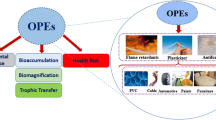Abstract
Background, Aims and Scope
Sediments of the Spittelwasser creek are highly polluted with organic compounds and heavy metals due to the discharge of untreated waste waters from the industrial region of Bitterfeld-Wolfen, Germany over the course of more than one century. However, relatively few data have been published about the chloroorganic contamination of the sediment. This paper reports on the content of different (chloro)organic compounds with special emphasis on polychlorinated dibenzo-p-dioxins and dibenzofurans (PCDD/F), and chlorobenzenes. Existing concepts for the remediation of Spittelwasser sediment include the investigation of natural attenuation processes, which largely depend on the presence of an intact microbial food web. In order to gain more insight in terms of biological activity, we analyzed the capacity of sediment microflora to degrade organic matter by measuring the activities of extracellular hydrolytic enzymes involved in the biogeochemical cycling of carbon, nitrogen, phosphorus and sulfur. Furthermore, the detection of physiologically active bacteria in the sediment, particularly of those known for their capability to reductively dehalogenate organochlorine compounds, illustrates the potential for intrinsic bioremediation processes.
Methods
PCDD/F and chlorobenzenes were analyzed by gas chromatography(GC)/mass spectrometry and GC/flame ionization detection, respectively. The activities of hydrolytic enzymes were determined from freshly sampled sediment layers using 4-methylumbelliferyl (MUF) or 7-amino-4-methylcoumarin-conjugated model compounds and kinetic fluorescence measurements. Physiologically active bacteria from different sediment layers were microscopically visualized by fluorescence in situ hybridization (FISH). Specific bacteria were identified by 16S rRNA gene amplification and sequencing.
Results and Discussion
The PCDD/F congener profile was dominated by dibenzofurans. In addition, the presence of specific tetra and pentachlorinated dibenzofurans supported the assumption that extensive magnesium production was one possible source for the high contamination. A range of other chloroorganic compounds, including several isomers of chlorobenzenes, hexachlorocyclohexane and 1,1,1-trichloro-2,2-bis (p-chlorophenyl)ethane (DDT), was present in the sediment. Activities of extracellular hydrolytic enzymes showed a strong decrease in those sediment layers that were characterized by high contents of absorbable organic halogen (AOX), indicating disturbed organic matter decay. Interestingly, an abnormal increase of cellulolytic enzyme activities below the organochlorine-rich layers was observed, possibly caused by residual cellulose from discharges of sulfite pulping wastes. FISH revealed physiologically active bacteria in most sediment layers from the surface down to the depth of about 60 cm, including members of Desulfitobacterium (D.) and Sulfurospirillum. The presence of D. dehalogenans was confirmed by its partial 16S rRNA gene sequence.
Conclusion
Results of chemical sediment analyses demonstrated high loads of organochlorine compounds, particularly of PCDD/F. Several years after stopping the waste water discharge to Spittelwasser creek, this sediment remains a main source for pollution of the downstream river system by way of the ongoing mobilization of sediment during high floods. As indicated by our enzyme activity measurements, the decomposition potential for organic matter is low in organochlorine-rich sediment layers. In contrast, the comparably higher enzyme activities in less organochlorine-polluted sediment layers as well as the presence of physiologically active bacteria suggest a considerable potential for natural attenuation.
Recommendations and Perspective
From our data we strongly recommend to explore the degradative capacity of sediment microorganisms and the limits for in situ activity towards specific sediment pollutants in more detail. This will give a sound basis for the integration of bioremediation approaches into general concepts to reduce the risk that permanently radiates from this highly contaminated sediment.
Similar content being viewed by others
Author information
Authors and Affiliations
Corresponding author
Rights and permissions
About this article
Cite this article
Bunge, M., Kähkönen, M.A., Rämisch, W. et al. Biological Activity in a Heavily Organohalogen-Contaminated River Sediment (8 pp). Env Sci Poll Res Int 14 (Suppl 1), 3–10 (2007). https://doi.org/10.1065/espr2006.03.298
Received:
Accepted:
Published:
Issue Date:
DOI: https://doi.org/10.1065/espr2006.03.298




